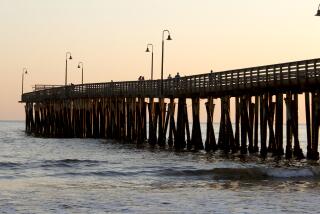Bluff Protection Plan Debated in Encinitas
An often boisterous crowd of 200 people jammed into the Encinitas City Council chambers Wednesday night to object to a proposal to place boulders on the beach to protect bluffs below expensive Neptune Avenue homes.
Man in the audience displayed homemade signs and buttons reading “No Riprap” and “Stop the Rocks.”
“We’re just looking for common sense from the City Council,” said Jack Cavanagh outside the council chambers. “All we want them to do is to take time to think about what they are doing.”
Twelve homeowners on Neptune Avenue, faced with eroding bluffs under their homes, want to place riprap 600 feet along the bottom of the bluff, sparking the current debate.
“I come to this meeting out of fear,” homeowner Arthur Auerbach said, “fear of losing our homes.”
The discussion went late into the night as the council wrestled with how to deal with homeowner applications to place protective devices on the beach.
Although the audience was there about the Neptune Avenue proposal, the council was not concerned with the specifics as much as it was in creating a policy for handling such proposals.
In September, the Encinitas City Council voted, 4 to 0 (with Pam Slater absent), to authorize city manager Warren Shafer to approve the installation of boulders or other protective devices in an emergency.
However, the council quickly stepped back from that position after protests from the public decried what they saw as preferential treatment for a few homeowners.
City staff recommended the city follow the lead of the California Coastal Commission, which also has jurisdiction over the beach. The staff recommends that only after the Coastal Commission determines that an emergency situation exists should the city consider temporary encroachments, following a series of conditions protecting the public’s access to the beach.
“We’re trying to make clear who will be ultimate authority in these matters,” Mayor Maura Wiegand said.
Consultant Bob Trettin, representing 30 beachfront residents, emphasized that the city should decide how to deal with homeowners’ needs to protect their homes. Emergency situations can “occur overnight,” he said. “We believe that we face some serious concerns this winter.” But the city has not determined that an emergency situation exists and many in the audience Wednesday night questioned the need for the riprap.
“It is not an emergency situation,” said Pete Munyan. “The sky is not falling.”
Some in the audience were less sure how to balance the homeowners’ concerns with the public’s right to use the beach--a common debate in coastal communities. And some expressed confusion about what was really best for the beach.
“It appears to me the council is at least trying to pay attention to what is happening,” Brent Wadsworth said.
The debate over whether private people should be allowed to use public beach to protect their homes has been fought up and down the California coast. Earlier this year, Del Mar, after years of legal squabbling, tore down seawalls and patios built on public beach by beachfront residents.
The California Coastal Commission, which must approve most plans for construction along the coast, has generally sided with the public’s right to beach access, except in emergencies.
This is the first time that Encinitas has been forced to deal with the issue in its six-year history. A council discussion Wednesday night was to develop a general policy, not about a specific project.
But encroachment became an issue because of the request by Neptune Avenue residents to put riprap in front of the bluffs below their homes. Their plan called for the boulders to extend 20 feet west of the bluffs.
The situation is complicated by the narrowness of the beach under the bluffs that front Neptune Avenue. Boulders would take away a significant stretch of the beach, which is already narrow or nonexistent during periods of high tide, opponents of the protection plan say.
A few weeks ago the city allocated $60,000 to hire a consultant to study the options. But a consultant hasn’t been hired yet.
Although many of the homes on Neptune were built on the bluff decades ago, others, such as the Auerbachs’, were built in the ‘80s when the area was under the jurisdiction of San Diego County.
More to Read
Sign up for Essential California
The most important California stories and recommendations in your inbox every morning.
You may occasionally receive promotional content from the Los Angeles Times.










